-
The Basics of Blood Sugar
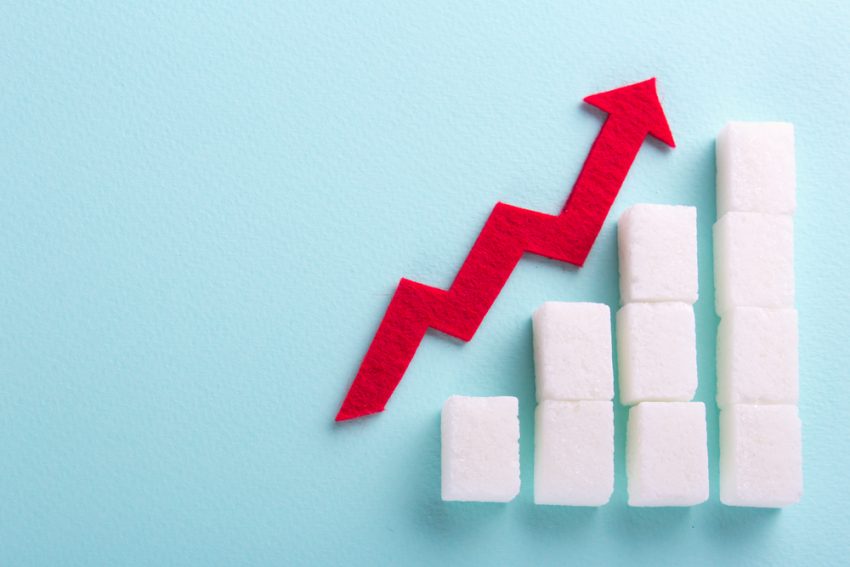
Are you concerned about your blood sugar? What is blood sugar and why does it matter so much?
It is possible, you have heard the term “blood sugar” before this article. Most people think of blood sugar and they think about the “blood sugar crash” we’ve all experienced before – feeling low energy, raging hungry and maybe even feeling shakey or experiencing those annoying tension headaches. What most people don’t realize is that this blood sugar low, it is almost always a result of a previous blood sugar high. The blood sugar spikes are what inevitably lead to those major crashes, but we are rarely talking about “blood sugar spikes” and what leads to them.
Before we get into the nitty gritty of blood sugar, it’s important to note that blood sugar isn’t just ‘a diabetes thing’ and it isn’t just an obesity thing. Every human, no matter their size, their age or their body type has blood sugar and any human can have blood sugar imbalances.
What is Blood Sugar / Blood Glucose?
Blood sugar, also known as blood glucose, is the amount of glucose present in your blood stream. Glucose in the bloodstream is affected most by the foods you eat. Your body creates glucose in the bloodstream by digesting these foods into a sugar that circulates in your bloodstream. Our body will then use that blood sugar for energy, then what isn’t currently needed for energy will get stored in the cells for later use.
Blood glucose levels are raised most significantly with carbohydrate foods, foods made from refined grains, breads, noodles and pastas, baked goods and pastries, sugar and sugary foods, but these carbohydrates also include grains in their whole state, starchy vegetables, fruits, etc. Yes, some of these carbohydrate foods can absolutely be a part of a healthy and well-balanced diet, it’s all about how much of these foods you eat at once and in what combination – this is what we need to be most aware of when it concerns blood sugar imbalances.
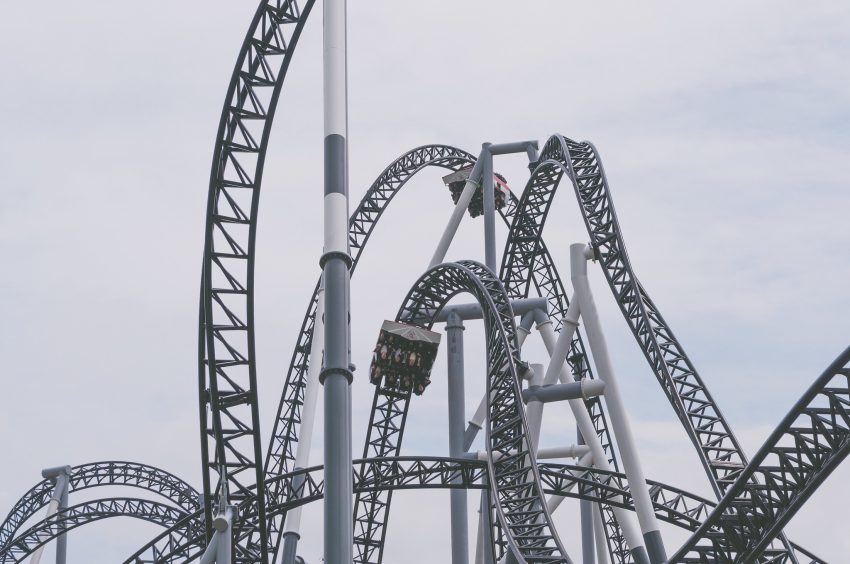
What Goes Up, Must Come Down
Where blood sugar (AKA blood glucose) is concerned, every single time you eat your blood sugar will rise, this is a natural, human response to food and energy production, how much so will depend on both the kind of food you are eating including the macronutrient profile of the food (which we will get to), as well as the quality and the quantity of that food and of course, the current health state of your body.
Unfortunately, thanks to the modern diet rich in simple carbohydrates (a diet common for many folks), the balanced, even blood sugar that our body has adapted to handle and manage with ease is far less common than not. A large influx of simple carbohydrates in a single meal, think pancakes with syrup at breakfast, a bagel, cereal, toast, a gigantic bowl of pasta for lunch, etc – this will lead to a swift rise in blood sugar levels. With a quick rise in blood sugar, our body sees this as an emergency that must be dealt with immediately.
How does the body deal with these blood sugar spikes? Let’s get into the basics of blood sugar regulation.
Blood Sugar Regulation
‣ When blood sugar rises this stimulates the pancreas to release insulin to help bring down blood sugar levels by storing away excess glucose as glycogen and triglycerides to be used later for energy.
‣ But insulin can overcorrect, causing blood glucose levels to drop too low (called reactive hypoglycemia), which the body also sees as an emergency.
‣ The central nervous system then signals the release of epinephrine and norepinephrine, followed by cortisol, to bring up blood sugar levels by converting glycogen and amino acids to glucose.Especially when we over-consume simple carbohydrates — which is very easy to do, for a variety of reasons including our genetic programming, the instant mood and energy boosts that we are often craving (thanks to stress, lack of sleep and blood sugar imbalances) and easy access to hyper-palatable processed foods — this same cycle can repeat over and over again throughout the day, eventually leading to blood sugar dysregulation, insulin resistance, possibly adrenal / HPA Axis issues (thanks to the excessive output of cortisol) and a myriad of symptoms associated with each of these.
The big players in the blood sugar system:
Most people don’t realize this, but the brain is the primary organ of blood sugar regulation, which in turn directs the activity of the following 5 primary peripheral organs and tissues via the:
- Pancreas
- Adrenals
- Adipose Tissue
- Liver
- Skeletal Muscle
AKA (the “PAALS”)
As well, the central nervous system works in tandem with these 5 primary hormones to help regulate blood sugar levels:
‣ Insulin – Insulin is produced by the beta cells of the pancreas and plays a very important role in regulating blood sugar levels. Insulin is essentially the key to unlock out cellular “gates” to let energy in, meaning the excess glucose found in the blood. The excess energy (glucose and fat) gets stored away in the cells of our liver, muscles, and fat tissue.
‣ Glucagon – Glucagon is produced by the alpha cells of the pancreas and it promotes the breakdown of glycogen to glucose in the liver. Glucagon balances insulin. When blood glucose levels drop sometime after eating this stimulates the release of glucagon for more energy. This cycle tells your cells to then release stored glycogen for energy to hold you over until your next meal. This cycle repeats itself throughout the day. Glucagon is essentially key that unlocks our cellular “gates” to let glucose and fat out of our cells.
‣ Epinephrine & Norepinephrine – Both epinephrine and norepinephrine are released when the body experiences a stress and it fears for it’s safety. Whether an external physical threat or internal, such as low blood sugar, these are part of the central nervous system’s fight or flee mechanism, designed to keep us safe. Epinephrine stimulates glycogenolysis in the liver, which converts glycogen to glucose, as well as lipolysis, which releases fatty acids from triglycerides stored in body fat and finally gluconeogenesis, which converts lactate, glycerol, and amino acids to glucose in the liver. All as a means to have the energy to fight or flee.
‣ Cortisol – Cortisol is a steroid hormone released when stress levels are high or blood sugar levels are too low. It increases the fuel (or energy) available to the heart and skeletal muscles in the same ways that epinephrine does, through stimulation of glycogenolysis, lipolysis and gluconeogenesis. However cortisol is slower to respond, taking minutes rather than seconds, since cortisol relies on the complex process of the HPA-Axis. (Another amazing topic for another day).
A really easy way to remember all of this: if blood sugar regulation were an orchestra, the central nervous system would be the conductor and the PAALS, the instruments.
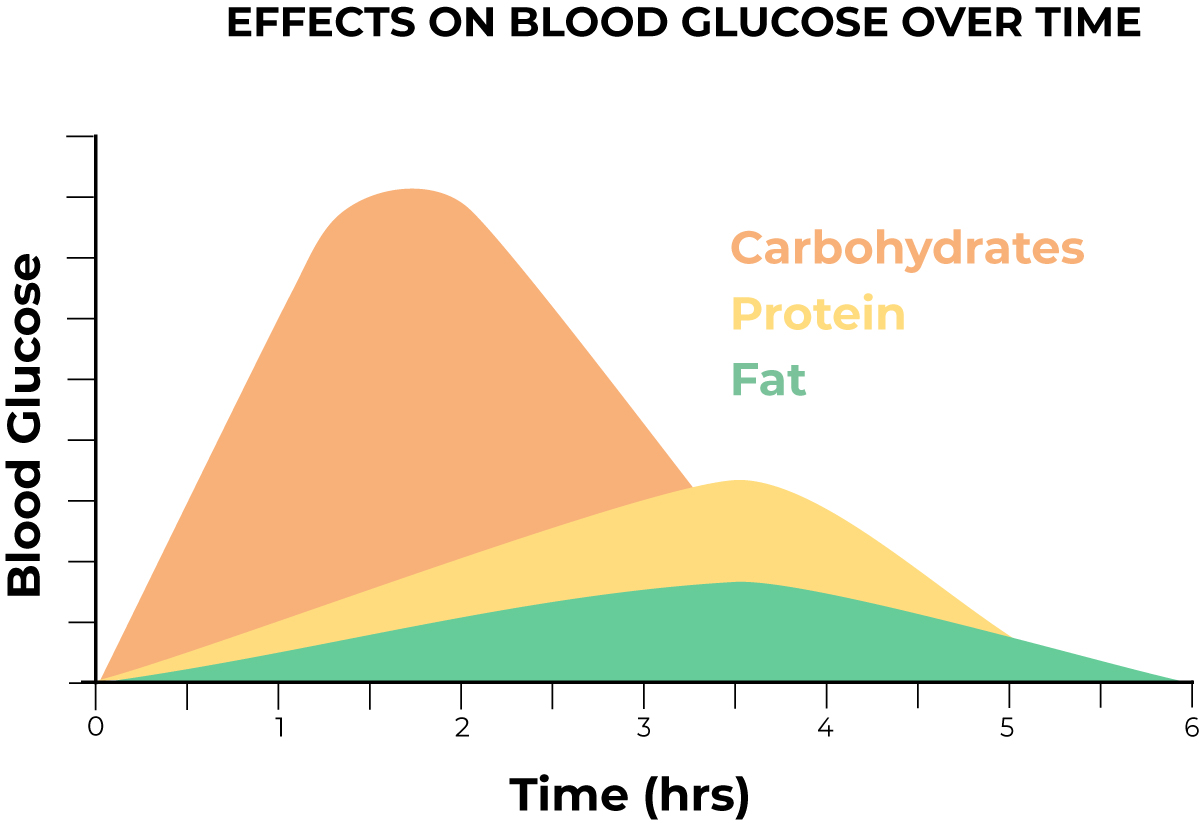
How the Food You Eat Affects Your Blood Sugar
Every single food we eat can be broken down into three macronutrient groups:
‣ Carbohydrates
‣ Protein
‣ Fat
Foods found in their whole food state are almost always dominant in one of these macronutrients over the others, but many foods contain a mixture. As mentioned previously, while all macronutrients will cause some increase in blood glucose levels, as you can see above carbohydrates will cause a larger increase than others, meaning the post meal crash that results will also be larger. Being aware of not only what types of foods you are consuming and how it affects your blood sugar is the first and easiest way to start balancing blood sugar levels and avoiding big spikes and huge crashes.
While you may be able to, at this point, do some simple reasoning and see how a meal of JUST carbs can cause an extreme blood sugar spike and crash, you may not still understand what foods fall under which categories, so let’s look at some other common foods.
Some examples of various foods and their dominant macronutrient group:
- Sweet potato: unrefined carbohydrate
- Boneless skinless chicken breast: protein
- Broccoli: unrefined carbohydrate
- Bacon: protein and fat
- Bowl of pasta: refined carbohydrate
- Apple: unrefined carbohydrate
- Eggs: protein and fat
- Steak: protein and some fat (more or less fat depending on the cut)
- Spinach: unrefined carbohydrate
- Whole Grain Rice: unrefined carbohydrate
- Avocado: fat and some carbohydrates
- Beans: unrefined carbohydrate and some plant-based protein
- Ice cream: refined carbohydrate and fat
In nature, carbohydrate-rich foods, in their whole food state almost always contain significant amounts of fiber. The fiber found in unrefined carbohydrates will actually slow down the effects on blood sugar as compared to a refined carbohydrate like a pastry, baked good, bread, pasta, juice, dessert, etc. which often have little in-tact fiber remaining. While fiber itself is a carbohydrate, it should not cause an increase in blood glucose or insulin as it is not digested by the small intestines and instead they make it to the large intestine where they are broken down by bacteria. In some cases fiber can actually decrease glucose and insulin levels. Fiber can been shown to improve insulin sensitivity, decrease heart disease risk and foster beneficial bacteria in our guts. Another benefits to fiber is that it “bulks up” and helps you to feel satiated and full.
In this same way when we combine our whole food carbohydrates with protein and fats, which we will get to in just a moment, the fiber found in whole food carbohydrates can provide an additional blunt to the blood sugar spike we would get from the carbohydrates alone. When we refine foods away from their whole food state, grains made into flour for baked goods, fruits that get juiced, sugar that is stripped of any nutrients, we are taking a direct hit of sugar to the blood and you know what comes next.
Added processed and refined fibers added to packaged and processed foods aren’t exactly the same as the in-tact fiber found in whole, unrefined foods as they are found in nature. Often these products advertised as low or no carb (because of the net carb approach) and they will often be loaded up with fibers, but it doesn’t mean these products are a good choice. Fibers added to processed foods like these may not cause the same response in the body that fiber found in whole foods will. Meaning it may still cause a glucose and insulin response and in some cases it may also cause some aggressive digestive issues. The FDA is currently investigating many of these “false fibers”.
PLEASE READ THIS AND THEN READ IT AGAIN:
Nutrient-dense, non-starchy vegetables like broccoli, spinach, cauliflower, kale, Brussels sprouts, cabbage, asparagus, mushrooms, peppers, zucchini, celery, cucumber, eggplant etc etc – these foods, while they are certainly more dominant in carbohydrates than protein or fat, they are so low in carbohydrates and so rich in fiber, vitamins, minerals and phytochemicals — that these should be consumed in unlimited abundance at every meal, without concern for blood sugar levels.
It’s also important to note that these main macronutrients are not the only foods / things that can cause a blood glucose spike. One randomized trial study showed that caffeinated coffee can impair the body’s ability to manage dietary glucose, resulting in higher blood sugar levels.1https://academic.oup.com/ajcn/article/87/5/1254/4650389 so it is important to always stay curious. In part two of this series we will be talking more about these other factors.
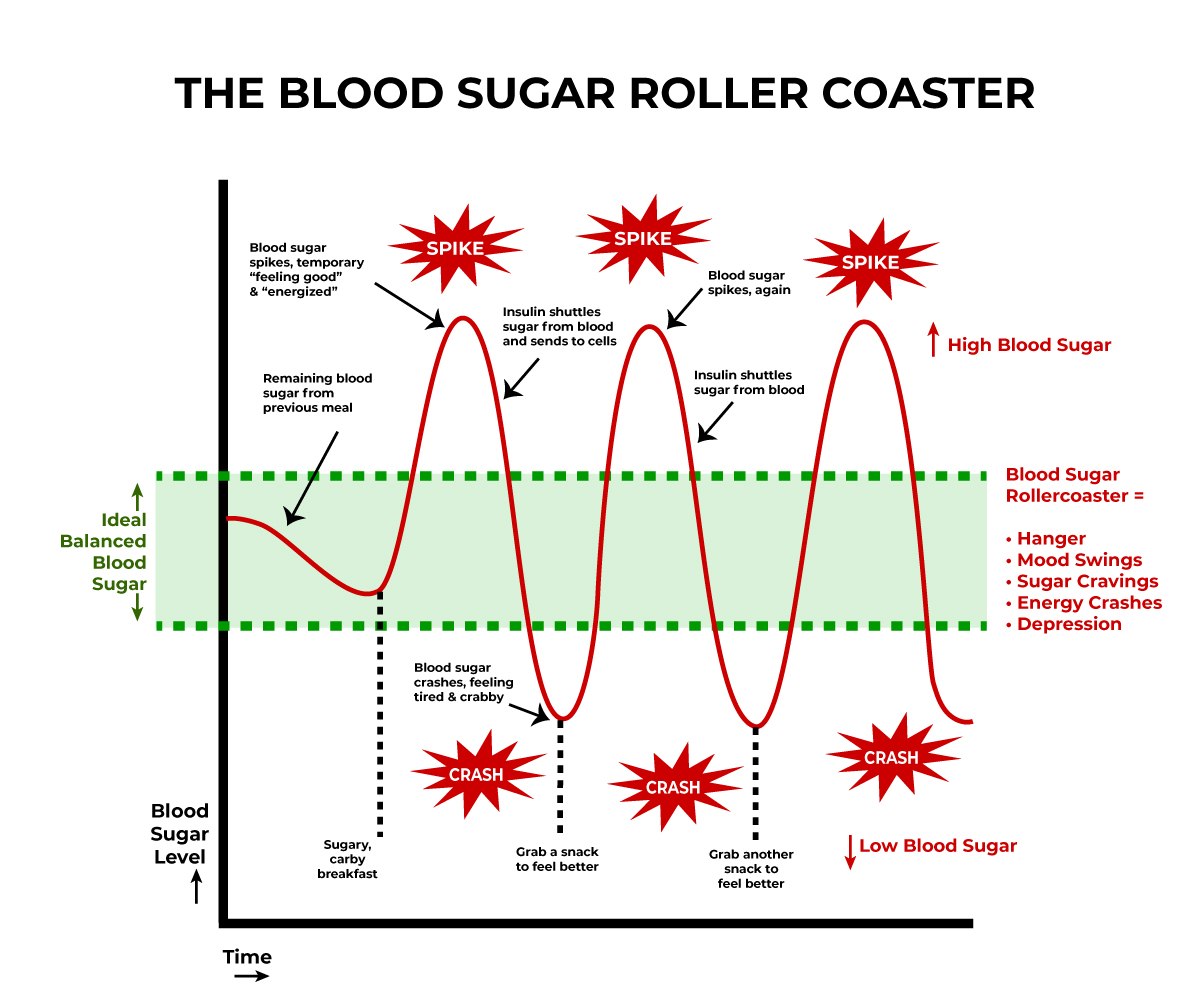
The consequences of constantly eating high sugar and high carb foods
As you can see, starting the day off with a carbohydrate-rich breakfast sets the tone for the day right out of the gate with a big blood sugar spike. Then comes the drop and if your choice for a snack, for a quick jolt of energy to bounce back is carb or sugar rich, you can see how the cycle continues. Your first meal sets the tone for the day and having balanced blood sugar levels all day means controlled energy levels, balanced moods, less cravings, no crashes or headaches and you aren’t continuously chasing your hunger.
How to Get off The Blood Sugar Roller Coaster – What Can You Do?
‣ Eat Enough Healthy Fats and Quality Proteins
Fat and protein have very little affect on blood glucose levels, compared to carbohydrates. Protein and fat also blunt the insulin release from the carbs on your plate. Protein and fat also send signals to your brain that you are full via important hunger hormones that help you avoid overeating. At every meal, prioritize a quality protein on your plate first, be sure you are including some healthy fats (read more about health fats here) if the protein you are eating is lean and doesn’t include enough on it’s own and fill the rest of your plate with nutrient-dense, colorful, in season non-starchy veggies. Dark leafy greens are one of my favorites for lots of important nutrients and fiber.
‣ Reduce Your Refined Carbohydrate Consumption and Avoid Excessive Sugar
Focus on quality of carbohydrates, balance of macronutrients (carbs not being the dominant), bio-individuality, everyone needs different amount of carbohydrates. Prioritize nutrient-dense whole food carbohydrates, think of a food that you could eat that you can imagine growing in nature, exactly as it is on your plate. These foods should be prioritized as your source of carbohydrates over refined carbohydrates and sugar-rich foods. The amount of carbohydrates each individual may need will depends on many factors, hormone health, HPA-axis health, age, gender, activity level, etc. If you determine that you do want/need to include more carbohydrate-dominant foods in your day, I recommend saving your starchy-veggies or carbohydrate-rich foods for your last meal of the day, this way, any drops in blood sugar are happening at a time of day where your energy would naturally be dipping to prepare for bedtime, any cravings that result won’t be a struggle. You will be asleep. Start the next day with a strong, protein and fat-rich breakfast so you can continue to keep things level and balanced throughout your day, with ease.
‣ Avoid Unnecessary, All-Day Snacking
Continuously eating, all day, will keep blood sugar levels either continuously elevated which means elevated insulin all day or it will be stuck in the loop of going up and down, all day. It’s not that snacking is inherently bad, but if you struggle with energy issues, if you crash halfway through the day, if you experience high highs and low lows that make you feel like you need to snack – this could be an indication you aren’t eating enough or properly at meal time or that your blood sugar is significantly imbalanced. Consider eating more at meal time and prioritizing protein and fat over carbohydrates and be sure you are eating enough. If you are eating protein and fat as the main focus of your meals and you are still feeling the need to snack all day, that this means you are likely not eating enough food. Focusing on both of these should help with the need to snack. If reducing your refined carbohydrates and sugar is a new way of eating for you, snacking may be helpful until your blood sugar levels are more balanced, so it is suggested that you consider protein and fat forward snacks when you you do snack. This post includes lots of options.
‣ Move Your Body
In our current, modern lifestyles where stress and sympathetic nervous system dominance becomes the norm, if we remain sedentary we the cortisol being released into our blood streams to keep circulating longer than it should. This can have detrimental long-term consequences but at the very least it can further dysregulate blood sugar levels. Physical movement can help stress management overall, but it can also help process out stress hormones that are present in the body more quickly, but movement is also an incredible method for using up excess blood sugar and increase insulin sensitivity. Even just one 30 minute session has been shown to improve insulin sensitivity by decreasing glycogen synthesis.2https://www.ncbi.nlm.nih.gov/pmc/articles/PMC3381815/
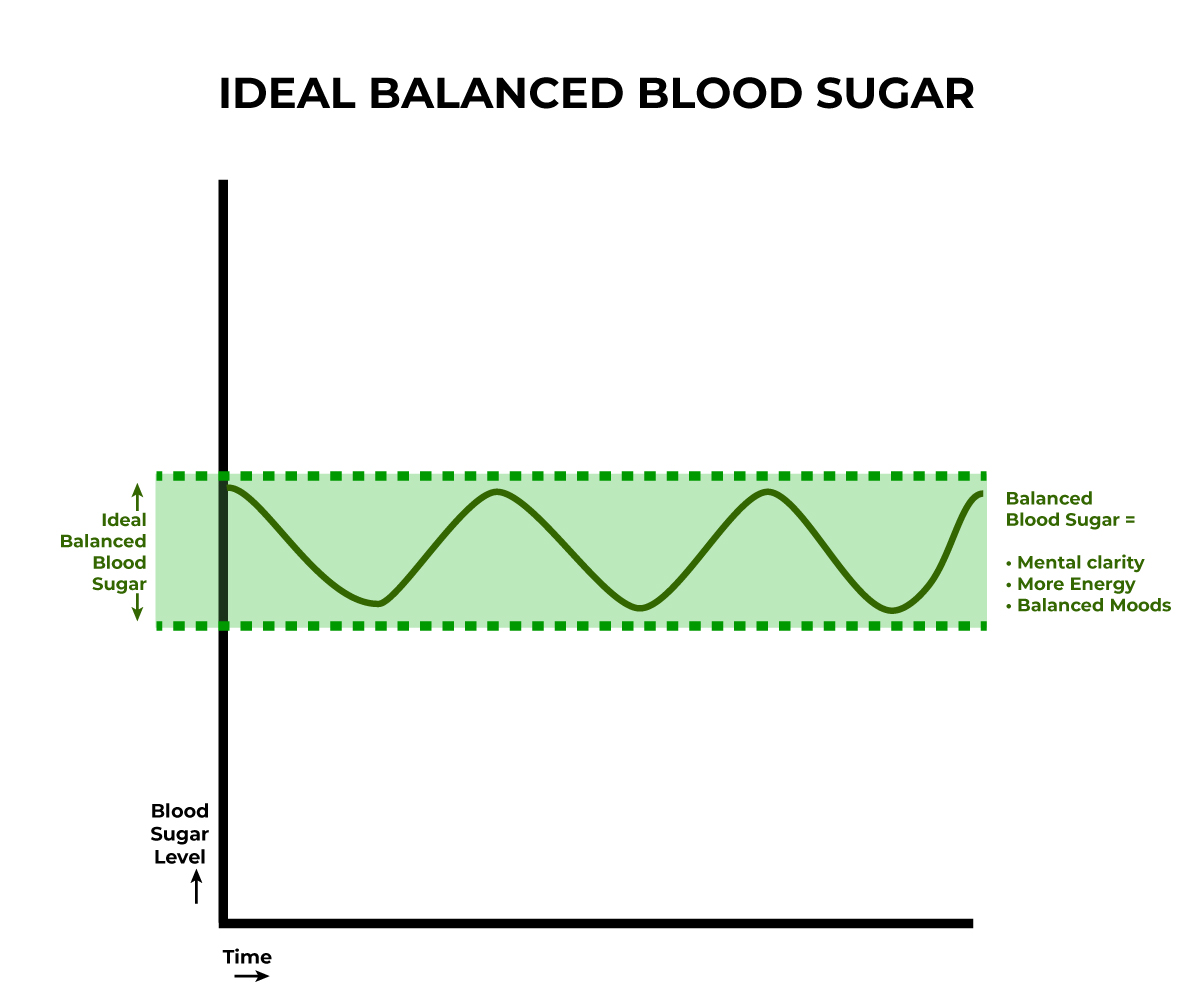
Looking for more support?
‣ Strong All Day Long
if you are experiencing daily energy crashes, hanger, cravings, mood swings and you are looking to make a few simple, easy-to-implement shifts right away, this 5-day program and 7-day meal plan are for you!! I am giving you the 5 big solutions I share with EVERY one of my 1:1 nutritional therapy clients, these shifts bring huge results with minimal efforts. There’s no diet, there isn’t a list a foods to avoid and nothing to track. You will learn how to create healthy plates of food, go more in depth on the various delicious quality proteins and fats to include, tips for meal planning to make eating easy, plus hidden sources of sugar and lots more. This is a focus on the foundations, simple approach to getting your blood sugar under control!! Learn more and get instant access to the program and your meal plan here.
‣ Keto for You
this program is designed to assist you in using a food-as-medicine, healing ketogenic approach to support your body is switching away from relying on sugar as it’s source of fuel. If you are the constant blood sugar roller coaster has resulted in metabolic dysfunction, an inability to lose fat, inflammation and joint pain, hormone imbalances and beyond and you are ready to get on the other side of these once and for all – this fully personalized nutrition program and masterclass will help you in finally taking control of your health and ditching the constant dieting roller coaster of on-again / off-again extreme restriction that never works. This 8 week program is full of customized nutritional protocols, supplement recommendations, 8 weeks of meal plans and recipes, weekly mindset practices, amazing expert guest teachers and in-depth learning so you can create a sustainable lifestyle that will be right for you. Learn more and sign up now here.
This program is designed to support you in using a ketogenic approach as a powerful intervention and healing tool to guide you in creating a sustainable fat-fueled lifestyle for yourself for long-term, so you can adjust and shift as life changes – so you can finally ditch the sugar fueled, blood sugar crashing, inflammation-causing approach that hasn’t been working for you. Head here to learn more and sign up. Enrollment is open for just a short time and the program will not be available again until later in 2020. If you aren’t sure if keto is the correct approach for you, you can watch this FREE online workshop Is Keto for You? to learn more or book a FREE 15-minute call with me and I am happy so answer your questions.
‣ 1:1 Nutritional Therapy and Health Coaching Support
If you are concerned there is more going on at a root cause level, possibly gut imbalances or pathogens, food sensitivities, complications from autoimmune disease or if you are looking for more direct 1:1 support including personalized action plans, lab testing and interpretations, supplemental support, if you are craving accountability and someone to help you dig deeper along side you, with nutritional support, lifestyle recommendations, mindset and mindfulness practices and more – working together one-on-one would be a really great option for you. You can apply to be a client here. Once I review your application, I will contact you about scheduling your FREE discovery call and we can decide if we are a good fit for one another.
PLEASE NOTE: Low post-meal blood sugar levels can happen to folks with normal fasting blood sugars, it can happen to someone who is insulin resistant and obviously in individuals with diabetes but it can also be a symptom of some types of Polycystic Ovarian Syndrome – with all of these scenarios, this type of low blood sugar is referred to, as mentioned above, reactive hypoglycemia. In most cases this type of low blood sugar can be treated with a lower carbohydrate approach, to balance blood sugar levels. Medically diagnosed hypoglycemia is different and should be treated with a health care practitioner, if you experience consistently low blood sugar levels and you are a diabetic on medication you may need to work with your doctor on changing your medication levels to match your carbohydrate intake. Ongoing low fasting blood sugar levels can also occur in people who do not have diabetes and can be the result of a serious underlying medical condition. If you have continuously low fasting blood sugar levels and do not take diabetes medications, you should see your healthcare provider.
Please Stay Tuned for Additional Articles in this Series Where You will Learn:
The Long-term Consequences of Imbalanced Blood Sugar
How Stress Affects Blood Sugar
Other Factors to Consider that Could Raise Your Blood Sugar
and More.
Got questions you want to be sure get covered in future articles, leave your comments below.
References
1. ↑ https://academic.oup.com/ajcn/article/87/5/1254/4650389 2. ↑ https://www.ncbi.nlm.nih.gov/pmc/articles/PMC3381815/ -
Cooking Fats and Oils: Which to Include and Which to Avoid
Cooking Fats and Oils: Which to Include and Which to Avoid
Fats and oils are a necessary part of cooking, but using the right ones are down right essential to living a healthy and vital life. Just like rest of what we eat, a good rule of thumb with fats and oils is to always opt for organic and you should avoid overly-processed, highly refined fats and basically anything that your grandmother wouldn’t recognize as traditional food (i.e. basically ALL highly-refined vegetable and seed oils) – but to be frank, there is a lot more to the story! Not only do the types and quality of fats and oils matter – but so does their proper use. Honoring the various molecular structures of the different fats is the best way to insure that you are using them appropriately, without causing damage to the fats and in turn, negative affects on our health.
Here is a quick resource guide including the various uses for each:
-
5 Mealtime Tips to Improve Digestion
Digestive dysfunction is easily the most common chronic ailment I encounter working as a Nutritional Therapist. As a follow-up to my in-depth series Digestion 101, I wanted to offer five, simple actionable steps that you can take right away to immediately begin the improvement of your digestion.Digestive dysfunction can have many faces – gas, bloating, stomach aches, indigestion – we’ve all been there. Yes, there are plenty of quick-fix, short term “bandaid” approaches to managing the symptoms, I see so many people that often pop antacids, take anti-gas, diarrhea or constipation meds just to get through the day. Sadly this only manages the symptoms of a larger problem and more often than not the root cause of the dysfunction is left untreated and the problems still persist.
Rather than popping pills or difficult, unnatural approaches, here are 5 simple, meal-time tips to improve your digestion, naturally.
5 Mealtime Tips to Improve Digestion
-
4 Reasons to Avoid Vegetable and Seed Oils
4 Reasons to Avoid Vegetable Oils. Vegetable oils are NOT healthy! Read on to discover the 4 biggest reasons to avoid these terrifying, toxic fats!
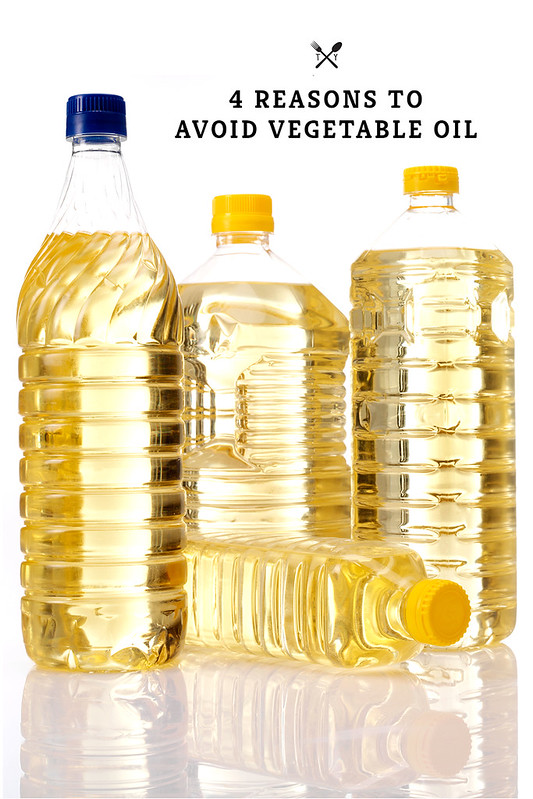
On the regular I find myself saddened and unpleasantly surprised by the lack of easily accessible, reliable information and data concerning food, nutrition and health. Truthfully, looking back, it’s amazing how little I myself knew, before I started down this long, self-initiated, ongoing path of nutritional education and empowerment of the past 10+ years. I am often reminded these days that I live in a bubble of sorts, surrounding myself virtually and otherwise with bloggers, healers, nutritionists and content creators whose lifestyles mirror my own. Reading books, listening to podcasts and following doctors and researchers creating and sharing important information and research about health and nutrition. I tend to forget and maybe I even take for granted, how much I do know and often I find myself making sweeping assumptions that everyone else knows most of it, too. I know for so many of you this post and this information is old news, it’s a rerun, you’ve heard it before. But if this post reaches even one new person, if I can send my new nutritional clients, who are still cooking with vegetable oils, here to learn more, then it’s a success!
As I enter the homes of my nutritional clients, as well as my close friends and family members, the number one thing I see among their food choices, that I immediately want to remove from their pantries and toss aggressively into the garbage: is vegetable and seed oils. In my opinion, vegetable oils are far worse than any overly refined carbs, white sugar or high fructose corn syrup. This deadly, Frankenstein-eque, lab-created “food” (if you can even call it that) is wreaking more havoc on people’s health than possibly anything else and sadly it’s being overlooked by so many. Much of this comes from Western medical practitioners who are woefully uneducated in nutrition or those whose nutritional education is sorely dated, built on antiquated and debunked health myths of previous generations. Or maybe it’s the fact that big food industry in our country has a large stake in corn and soy production and these have become, by far, the cheapest crops we are growing, thanks to government subsidies. Take a look at most packaged and processed foods and I can almost guarantee you will find one or both of these foods somewhere on the label.
The edible oil industry in our country, “Big Ag” and their marketing “geniuses” sought to demonize tropical oils and other saturated fats and in turn, in the same breath to promote their own vegetable oils, like corn and soybean oil. This great movement toward the excessive use of polyunsaturated fats and the demonization of saturated fats came with the advent of the “Lipid Hypothesis” — which featured fraudulent research made by a terrible scientist named Ancel Keys who made unsubstantiated claims that saturated fat and cholesterol were the cause of heart disease and ignored research and data that didn’t support his argument. We can see how well all that has gone!
The fats used in this study were hydrogenated, processed fats, known to be extremely irritating to the body, particularly the vascular system. Cholesterol acts as a healing agent to repair and protect the arteries and veins. Therefore, the more irritation, the more cholesterol will mobilize to save the day! Research now shows us that dietary cholesterol intake has VERY LITTLE to do with over all cholesterol levels, so this part of the theory was off target as well. Today, the Lipid Hypothesis continues to be promoted by most medical professionals and pharmaceutical companies, as well as the modern food processing giants, who profit from such flawed research. Saturated fatty acids from healthy sources nourish the vascular system, enhance immune function, protect the liver from certain toxins (including alcohol), aid in calcium absorption, and increase cellular membrane integrity. Keep in mind that heart disease was considered a rare condition before the 1920’s, but spiked dramatically from 1910 to 1970 as Americans began consuming less saturated animal fats and increasing amounts of vegetable fats in the form of margarine, shortening and adulterated, refined oils of all types. Our not-so-distant ancestors consumed healthy sources of saturated fats each and every day with no adverse health effects whatsoever! 1Fats: Safer Choices for Your Frying Pan and Your Health By Caroline Barringer, CHFS, NTP
After going through the Nutritional Therapy program at the NTA to become a certified Nutritional Therapy Practitioner I have found myself more inspired than ever to want to help people, to share what I know and to do whatever I can to help make a change in our health, our very broken food system and to empower people to make the very best choices for themselves and their families. So let’s start with one of the most important topics: 4 Reasons to Avoid Vegetable and Seed Oils!
What are Vegetable Oils?
Vegetable oils are oils that are extracted from seeds, germs or beans, such as corn, sunflower, safflower, soybean, or rapeseed (canola oil), etc. Non existent until the early-1900’s, vegetable oils are one of the most unnatural “foods” you can find. Vegetable oils are PUFAs, which stands for Poly-Unsaturated Fatty Acid. In chemical terms, that means that the fatty acid has more than one (poly) double bond in the carbon chain. They’re unsaturated because they’re missing out on what saturated fatty acid has — hydrogen atoms. In a sense, that makes the bonds sort of incomplete. So, imagine a chain of links that are sort of missing a joint or two, on each and every link — it wouldn’t be very strong or stable. These messed up and broken chains make for highly unstable fats that are prone to oxidation in the presence of heat and light, during cooking, sitting on the shelf in the grocery store or in your kitchen pantry and even in your body and they turn rancid, which our body reacts terribly to. Our body attempts to respond to and neutralize the oxidization by utilizing its stores of antioxidants. This oxidization process causes cell mutation, which we see in chronic inflammation, the source of most of the worst illness plaguing our society, cancer, heart disease, etc.
It’s really pretty simple. Because of their instability, and the negative effects on the body’s systems these oils have in excess, PUFA are just plain bad.
The most common vegetable oils on the market are:
- soybean oil
- canola oil (rapeseed oil)
- sunflower oil
- corn oil
- cottonseed oil
- “vegetable” oil
- safflower oil
- peanut oil
- grapeseeed oil
- rice bran oil
- margarine
- shortening (made from above oils)
- fake butter or spreadable butter-type spreads (I Can’t Believe it’s Not Butter, Earth Balance, Smart Balance)
Thankfully less and less people are cooking with these oils at home these days, however unfortunately it’s still not enough to just not buy these cooking oils at the store. Be aware that many/most processed foods contain these oils so you have to be sure to read labels. Salad dressings, condiments like mayo, sauces, crackers, cookies, chips… check your ingredients. You can also bet that most restaurants are cooking in vegetable oils, because they are so cheap! Unless a restaurant specifically states otherwise, their fried foods are all cooked in soybean, cottonseed or some other highly toxic vegetable oil.
(Note the term “vegetable oil” does NOT apply to healthy plant oils like olive oil or coconut oil, which are extremely healthful)
4 Reasons to Avoid Vegetable Oils
References
1. ↑ Fats: Safer Choices for Your Frying Pan and Your Health By Caroline Barringer, CHFS, NTP







